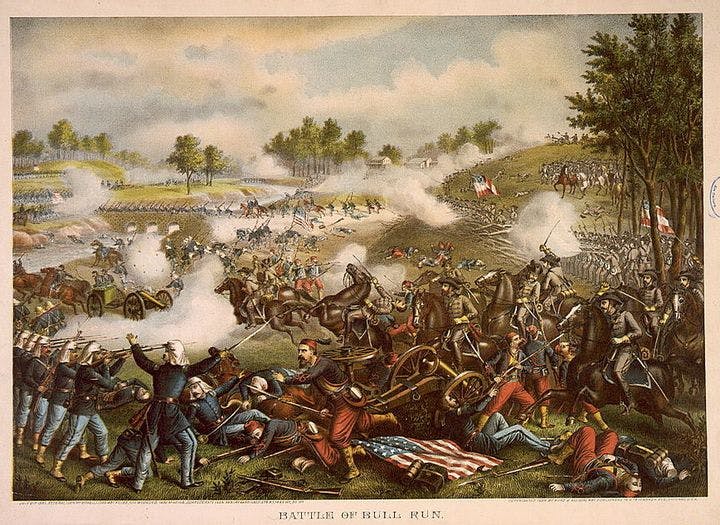Summer 2011
They Were There
– Tim Morris
Theatrics are history too.
The Civil War: The First Year Told by Those Who Lived It is the first of a projected four-volume series from the Library of America, to be released annually during the war’s sesquicentennial. The series will include journalistic accounts, state papers, speeches, diaries, letters, sermons, and even poetry and songs, all of which are meant, the editors say, to offer a narrative of the war years. But if it’s narrative in conception, the first volume is largely rhetorical in content. It hovers somewhere between academic source book and the old educational TV series You Are There. Serious collectors of Civil War books will want to own it, and teachers of Civil War history will want to assign it. But the reader looking for a true narrative might be better off staying with one of the many excellent secondary and analytical histories, such as James M. McPherson’s Battle Cry of Freedom (1988).
We like to think that going back to primary sources gives us an unbiased, unmediated look at the past. Of course, Americans of 150 years ago were no strangers to editorial bias. Every opinion, even every sensory perception, recorded in the documents in The Civil War: The First Year is filtered through a writer’s ideologies. “Most of these documents were not written for publication,” observe the editors. But these private thoughts often bear the stamp of public rhetoric, showing how conscious the writers were of the narratives they were spinning. North Carolinian Catherine Edmonston, who witnessed Union attempts to resupply Fort Sumter, wrote in her diary, “The North is sowing the wind; see that ere the next generation she does not reap the Whirlwind!”
That is not to say that the texts collected in The Civil War: The First Year are uniform in genre or style. They are highly eclectic, ranging from public pronouncements to intimate family letters, from as-it-happened reporting to decades-later recollection, from calculating persuasive addresses to matter-of-fact life records.
Charles Haydon’s diary for May 1861 falls into this last category. Haydon was a sergeant in a Michigan volunteer unit, and the extracts from his diary reproduced here concern his initial deployment to a camp outside Detroit. In these few pages we get a spare sketch of the dull tension of life among men going off to war. “Nearly all the men have diarhea [sic] & several are in the hospital quite sick”: That was the overwhelming daily reality of Civil War armies. Yet in these pages Haydon never leaves Michigan, never bears witness to what we’ve come to regard as the great historical events of the war.
In contrast to Haydon’s unselfconsciousness, there’s former Union officer Abner Doubleday’s account of the fall of Fort Sumter. Doubleday published his memoirs in 1876, by which time the defense of Sumter had passed into legend. “In aiming the first gun fired against the rebellion I had no feeling of self-reproach, for I fully believed that the contest was inevitable, and was not of our seeking,” he wrote. In all likelihood, the Doubleday of 1861 was more concerned about artillery technique than justifications for deadly force. But he wasn’t journaling while he was firing.
The Civil War: The First Year shows us actors who knew they were onstage, some of whom had been scripting their parts for years. “The enemy carried out their programme” is Doubleday’s curious way of putting it. Theatrics are history too.
* * *
Tim Morris teaches American literature at the University of Texas, Arlington, and compiles the online bibliography Guide to Civil War Novels.
Reviewed: The Civil War: The First Year Told by Those Who Lived It edited by Brooks D. Simpson, Stephen W. Sears, and Aaron Sheehan-Dean, Library of America, 814 pp, 2011.
Image courtesy of Wikimedia Commons
